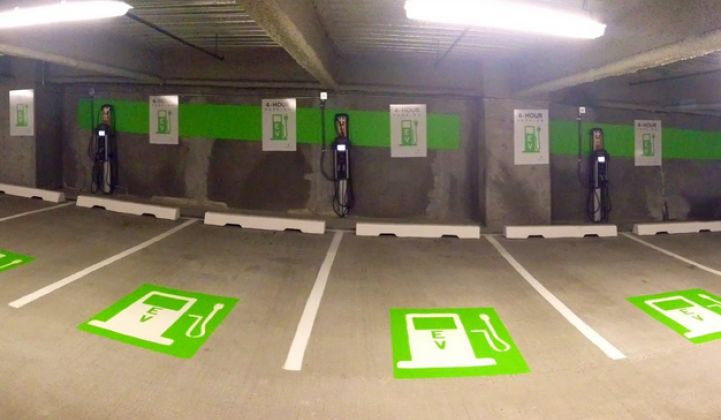Building a network of electric-vehicle charging stations to replace the corner gas station network we have today will take billions of dollars, eventually. It’s taking hundreds of millions of dollars to bring ChargePoint up to scale.
On Tuesday, the Campbell, Calif.-based startup announced a $50 million investment led by Linse Capital, and joined by Braemar Energy Ventures and Constellation Energy. The Series F round brings ChargePoint’s total investment to north of $164 million, with previous backers including Kleiner Perkins, Rho Ventures, and strategic investors BMW iVentures and Siemens.
ChargePoint has about 28,000 public charging systems in its network. Outside a handful overseas in cities like Amsterdam, Sydney and Dublin, they’re deployed across the United States and Canada. The most, nearly 8,000, are in California, but there are thousands apiece in states including Texas, New York, Florida and Washington -- here’s a map with state-by-state data.
That makes it the largest EV-charging provider in the country, ahead of such contenders as NRG Energy’s EVGo network, and Car Charging Group, owner of the network of Blink stations built out by now-bankrupt Ecotality.
While most of its stations are Level 2 AC chargers, ChargePoint does connect a handful of fast-charging stations, and got into the residential and multifamily-housing market last year with its ChargePoint Home product.
ChargePoint doesn’t own the stations themselves. But it does provide the underlying technology to connect the stations with EVs, their drivers and the business or company that hosts them, to manage pricing, payments, service, and all the other aspects of running an electric gas station. It works with long list of EV charging-system partners, including some, like Siemens, that are also investors.
ChargePoint’s latest strategic investor, Constellation, has been working with it since September on a program to allow energy customers to pay back the cost of an EV-charging station through their energy supply agreements -- that is, on-bill payment. Financing is a key part of expanding EV charging deployments, since installing one can cost tens of thousands of dollars in equipment, labor and electric service upgrade costs. Back in 2013, ChargePoint announced a $100 million equipment lease financing fund with Key Equipment Finance that similarly reduced the cost of EV chargers to dollars per day.
The EV charger market is still relatively small, with much of the existing infrastructure funded by government grants, like the Department of Energy program that’s funded about 4,600 of ChargePoint’s home and business charging systems. For the most part, they’re seen by the businesses, companies or government entities that host them as a way to encourage EV adoption, attract EV drivers to shop or visit, and otherwise serve the relatively small, but potentially valuable, market of early adopters.
As for the actual electricity that’s bought and sold at each station, that can be given away for free, paid for through flat monthly fees, by volume, or through more complex real-time variable pricing options. Utilities or energy companies can also manage chargers in aggregate to help balance load-supply curves or mitigate overuse on loaded circuits.
At the same time, utility deployments like the 5,000-charger rollouts being planned by California utilities Southern California Edison and San Diego Gas & Electric are meant to help open up underserved markets, such as multifamily housing. Apartments, condos and other shared-parking facilities can struggle with higher-than-usual installation and electric service costs, as well as the challenge of how to share costs and benefits between property owners, management companies and tenants.
ChargePoint has also done some work in settings that have solar power or batteries to add to the energy mix. Its project with Green Charge Networks is using batteries and EV-charger scheduling and control to make sure a Silicon Valley school doesn’t spike its electricity demand profile and absorb costly demand charges, for example.
As for the need for growth capital, ChargePoint’s press release noted that 2015 EV sales grew 80 percent over the previous year to 565,000, and that upcoming models like the Tesla Model 3 and the Chevy Bolt are exciting consumer appetite for an affordable all-electric alternative.



